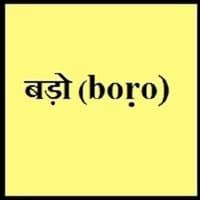Cebuano vs Bodo
Countries
Philippines
Assam, India
National Language
Philippines
Assam, India
Second Language
Philippines
Not Available
Speaking Continents
Asia
Asia
Minority Language
Not spoken in any of the countries
Not Available
Regulated By
Visayan Academy of Arts and Letters
Not Available
Interesting Facts
- About one-fifth of the population of the philippines speak cebuano and are second largest ethnolinguistic group in the country.
- Cebuano contains many words of Spanish origin.
- In ancient times, Bodo language was written using Assamese script and Roman script.
- Bodo Language is written using Devanagari script since 1963.
Similar To
Hiligaynon Language
Dimasa language, Garo language, Kokborok language
Derived From
Island of Cebu
Not Available
Alphabets in
Cebuano-Alphabets.jpg#200
Bodo-Alphabets.jpg#200
Writing Direction
Not Available
Not Available
Language Levels
Not Available
Time Taken to Learn
Not Available
Thank You
Salamat
Not Available
How Are You?
Kumusta man ka?
Nungni khabora ma?
Good Night
Maayong Gabii
मोजां हर (Mwjang Hor)
Good Evening
Maayong Gabii
Not Available
Good Afternoon
Maayong Hapon
Not Available
Good Morning
Maayong Buntag
मोजां फुं (Mwjang Fung)
Please
Palihug
अननानै (Onnanwi)
Sorry
Ikasubo ko
Not Available
I Love You
Gihigugma ko ikaw
अननाइ नों (onnai Nwng)
Excuse Me
Ekskyus mi
Not Available
Dialect 1
Boholano
(Sønabari) Western Boro dialect
Where They Speak
Bohol
Bongaigaon, Kokrajhar
Dialect 2
Southern Kana
(Sanzari) Eastern Boro dialect
Where They Speak
southern Leyte
Barpeta, Darrang, Kamrup, Nalbari
Dialect 3
North Kana
(Hazari) Southern Boro dialect
Where They Speak
northern part of Leyte
Assam, India, Nepal
How Many People Speak?
Not Available
Speaking Population
Not Available
Second Language Speakers
Not Available
Native Name
Visayan
बड़ो (boṛo)
Alternative Names
Binisaya, Bisayan, Sebuano, Sugbuanon, Sugbuhanon, Visayan
Bara, Bodi, Boro, Boroni, Kachari, Mech, Meche, Mechi, Meci
French Name
cebuano
Not Available
German Name
Cebuano
Not Available
Pronunciation
Not Available
[bɔɽo]
Ethnicity
Cebuano people
Bodo, Mech, (Assamese)
Language Family
Austronesian Family
Sino-Tibetan Family
Subgroup
Not Available
Tibeto-Burman
Branch
Not Available
Not Available
Early Forms
No early forms
Not Available
Standard Forms
Standard Cebuano
Not Available
Language Position
Not Available
Signed Forms
Not Available
Not Available
Scope
Individual
Individual
ISO 639 1
No data Available
Not Available
ISO 639 2/T
ceb
Not Available
ISO 639 2/B
ceb
Not Available
ISO 639 6
Not Available
Not Available
Glottocode
cebu1242
bodo1269
Linguasphere
No data Available
Not Available
Language Type
Living
Living
Language Linguistic Typology
Verb-Subject-Object
Not Available
Language Morphological Typology
Not Available
Not Available
Cebuano and Bodo Language History
Comparison of Cebuano vs Bodo language history gives us differences between origin of Cebuano and Bodo language. History of Cebuano language states that this language originated in 16th century whereas history of Bodo language states that this language originated in 1913. Family of the language also forms a part of history of that language. More on language families of these languages can be found out on Cebuano and Bodo Language History.
Cebuano and Bodo Greetings
People around the world use different languages to interact with each other. Even if we cannot communicate fluently in any language, it will always be beneficial to know about some of the common greetings or phrases from that language. This is where Cebuano and Bodo greetings helps you to understand basic phrases in Cebuano and Bodo language. Cebuano word for "Hello" is Hoy or Bodo word for "Thank You" is Not Available. Find more of such common Cebuano Greetings and Bodo Greetings. These greetings will help you to be more confident when conversing with natives that speak these languages.
Cebuano vs Bodo Difficulty
The Cebuano vs Bodo difficulty level basically depends on the number of Cebuano Alphabets and Bodo Alphabets. Also the number of vowels and consonants in the language plays an important role in deciding the difficulty level of that language. The important points to be considered when we compare Cebuano and Bodo are the origin, speaking countries, language family, different greetings, speaking population of these languages. Want to know in Cebuano and Bodo, which language is harder to learn? Time required to learn Cebuano is 3 weeks while to learn Bodo time required is Not Available.





